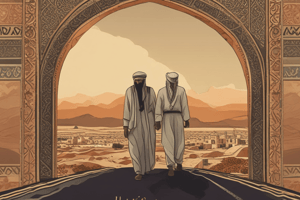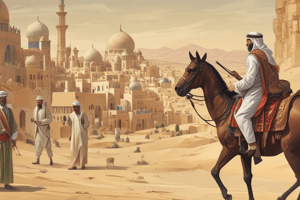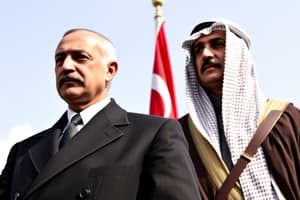Podcast
Questions and Answers
What does the fundamentalist movement in the Middle East call for?
What does the fundamentalist movement in the Middle East call for?
Adherence to Islamic political traditions.
Which statement best describes Hamas?
Which statement best describes Hamas?
Hamas is a Palestinian group that opposes Israeli rule.
In the 1940s and 1950s, pan-Arabism grew in the Middle East in response to what?
In the 1940s and 1950s, pan-Arabism grew in the Middle East in response to what?
Growing influence from Western nations.
Who led the Turkish nationalists in the 1920s?
Who led the Turkish nationalists in the 1920s?
How did Iran change under Ayatollah Khomeini?
How did Iran change under Ayatollah Khomeini?
In which country has the Muslim Brotherhood become an accepted political party?
In which country has the Muslim Brotherhood become an accepted political party?
What were the causes of the Arab Spring movement? (Select all that apply)
What were the causes of the Arab Spring movement? (Select all that apply)
What was one reform that helped transform Turkey in the 1920s?
What was one reform that helped transform Turkey in the 1920s?
Why did Islamic clerics criticize the shah of Iran?
Why did Islamic clerics criticize the shah of Iran?
How did Mustafa Kemal differ from Abd al-Aziz Ibn Saud?
How did Mustafa Kemal differ from Abd al-Aziz Ibn Saud?
Flashcards are hidden until you start studying
Study Notes
Fundamentalism in the Middle East
- The fundamentalist movement emphasizes adherence to Islamic political traditions as a guiding principle.
Hamas
- Hamas is identified as a prominent Palestinian group opposing Israeli governance over Palestinian territories.
Pan-Arabism
- Pan-Arabism emerged during the 1940s and 1950s largely in reaction to increasing Western influence in the Middle East.
Turkish Nationalism
- Mustafa Kemal, a key figure in the 1920s, led the nationalists in Turkey and initiated significant reforms.
Iran Under Khomeini
- After Ayatollah Khomeini came to power, religious leaders began to shape official policy in Iran, marking a shift towards theocracy.
Muslim Brotherhood
- The Muslim Brotherhood is recognized as an established political party in Egypt, playing a significant role in the political landscape.
Arab Spring Movement
- The Arab Spring was fueled by widespread protests against various issues, including high poverty rates, unemployment, demands for governmental reforms, and rejection of autocratic leadership.
Reforms in Turkey (1920s)
- One notable reform in 1920s Turkey was the granting of voting rights to women, reflecting a move towards modernization and gender equality.
Critique of the Shah
- Islamic clerics in Iran criticized the Shah for his policies favoring Westernization, which they viewed as incompatible with Islamic values.
Comparison of Leaders
- Mustafa Kemal focused on the modernization of Turkey, contrasting sharply with Abd al-Aziz Ibn Saud's approach of reinforcing traditional values in Saudi Arabia.
Studying That Suits You
Use AI to generate personalized quizzes and flashcards to suit your learning preferences.




